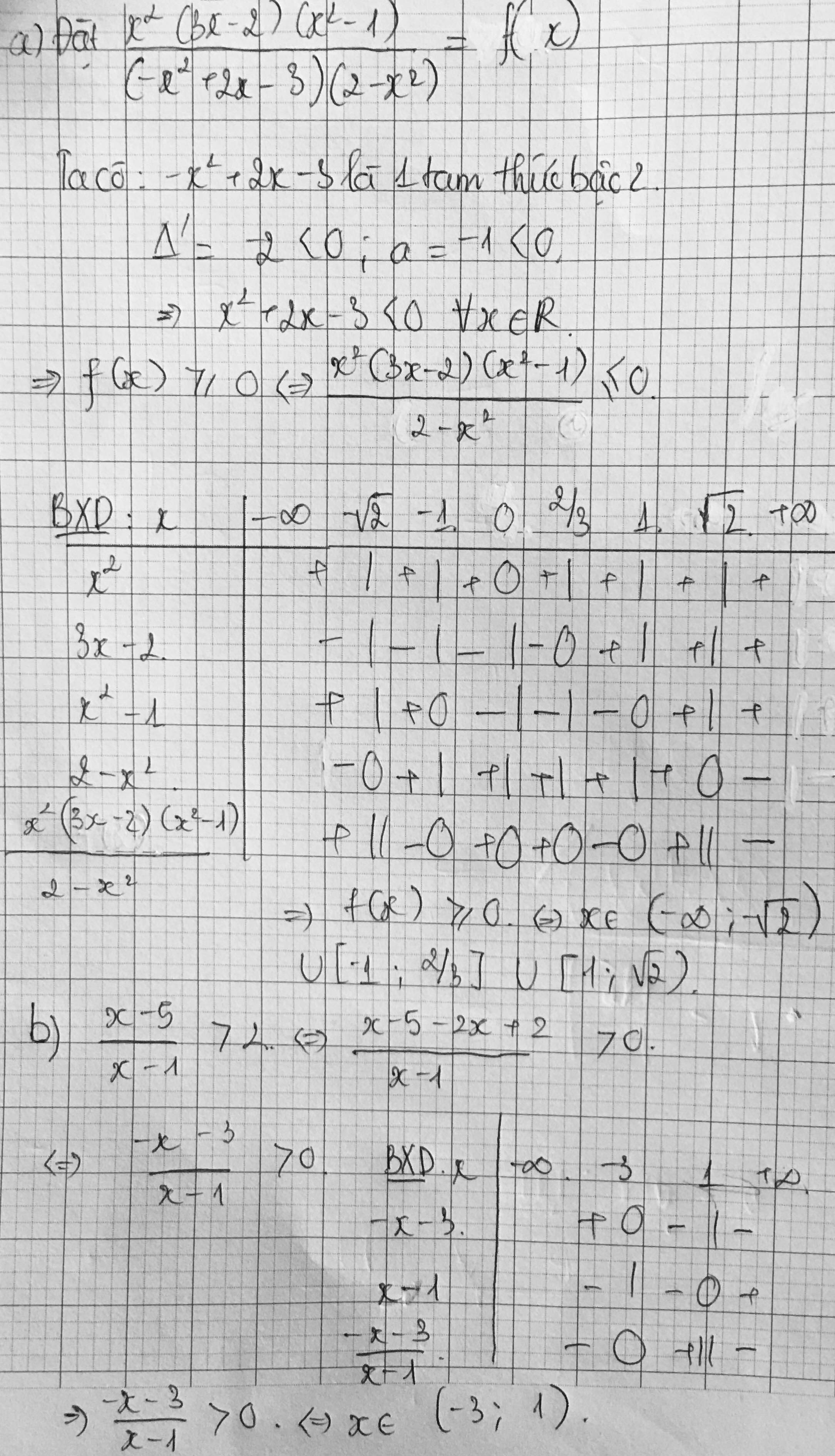Hãy nhập câu hỏi của bạn vào đây, nếu là tài khoản VIP, bạn sẽ được ưu tiên trả lời.

a, ĐKXĐ : \(D=R\)
BPT \(\Leftrightarrow x^2+5x+4< 5\sqrt{x^2+5x+4+24}\)
Đặt \(x^2+5x+4=a\left(a\ge-\dfrac{9}{4}\right)\)
BPTTT : \(5\sqrt{a+24}>a\)
\(\Leftrightarrow\left[{}\begin{matrix}\left\{{}\begin{matrix}a+24\ge0\\a< 0\end{matrix}\right.\\\left\{{}\begin{matrix}a\ge0\\25\left(a+24\right)>a^2\end{matrix}\right.\end{matrix}\right.\)
\(\Leftrightarrow\left[{}\begin{matrix}-24\le a< 0\\\left\{{}\begin{matrix}a^2-25a-600< 0\\a\ge0\end{matrix}\right.\end{matrix}\right.\)
\(\Leftrightarrow\left[{}\begin{matrix}-24\le a< 0\\0\le a< 40\end{matrix}\right.\)
\(\Leftrightarrow-24\le a< 40\)
- Thay lại a vào ta được : \(\left\{{}\begin{matrix}x^2+5x-36< 0\\x^2+5x+28\ge0\end{matrix}\right.\)
\(\Leftrightarrow-9< x< 4\)
Vậy ....
b, ĐKXĐ : \(x>0\)
BĐT \(\Leftrightarrow2\left(\sqrt{x}+\dfrac{1}{2\sqrt{x}}\right)< x+\dfrac{1}{4x}+1\)
- Đặt \(\sqrt{x}+\dfrac{1}{2\sqrt{x}}=a\left(a\ge\sqrt{2}\right)\)
\(\Leftrightarrow a^2=x+\dfrac{1}{4x}+1\)
BPTTT : \(2a\le a^2\)
\(\Leftrightarrow\left[{}\begin{matrix}a\le0\\a\ge2\end{matrix}\right.\)
\(\Leftrightarrow a\ge2\)
\(\Leftrightarrow a^2\ge4\)
- Thay a vào lại BPT ta được : \(x+\dfrac{1}{4x}-3\ge0\)
\(\Leftrightarrow4x^2-12x+1\ge0\)
\(\Leftrightarrow x=(0;\dfrac{3-2\sqrt{2}}{2}]\cup[\dfrac{3+2\sqrt{2}}{2};+\infty)\)
Vậy ...

a)
\(\left\{{}\begin{matrix}x^2\ge\dfrac{1}{4}\left(1\right)\\x^2-x\le0\left(2\right)\end{matrix}\right.\)
\(\left(1\right)x^2-0,25\Leftrightarrow\left[{}\begin{matrix}x\le-\dfrac{1}{2}\\x\ge\dfrac{1}{2}\end{matrix}\right.\)
(2)\(x^2-x\le\) \(\Leftrightarrow0\le x\le1\)
Kết hợp (1) và (2) \(\Rightarrow\dfrac{1}{2}\le x\le1\)
b)
\(\left\{{}\begin{matrix}\left(x-1\right)\left(2x+3\right)>0\left(1\right)\\\left(x-4\right)\left(x+\dfrac{1}{4}\right)\le0\left(2\right)\end{matrix}\right.\)
Giải: \(\left(1\right)\left(x-1\right)\left(2x+3\right)>0\Leftrightarrow\left[{}\begin{matrix}x< -\dfrac{3}{2}\\x>1\end{matrix}\right.\)
Giải: (2) \(\left(x-4\right)\left(x+\dfrac{1}{4}\right)< 0\Leftrightarrow-\dfrac{1}{4}\le x\le4\)
Kết hợp điều kiện của (1) và (2) ta có: (1;4] là nghiệm của hệ bất phương trình.

\(\dfrac{2x-1}{x+1}-2< 0.\left(x\ne-1\right).\\ \Leftrightarrow\dfrac{2x-1-2x-2}{x+1}< 0.\Leftrightarrow\dfrac{-3}{x+1}< 0.\)
Mà \(-3< 0.\)
\(\Rightarrow x+1>0.\Leftrightarrow x>-1\left(TMĐK\right).\)
\(\dfrac{x^2-2x+5}{x-2}-x+1\ge0.\left(x\ne2\right).\\ \Leftrightarrow\dfrac{x^2-2x+5-x^2+2x+x-2}{x-2}\ge0.\\ \Leftrightarrow\dfrac{x+3}{x-2}\ge0.\)
\(\Leftrightarrow\left[{}\begin{matrix}\left\{{}\begin{matrix}x+3\ge0.\\x-2\ge0.\end{matrix}\right.\\\left\{{}\begin{matrix}x+3\le0.\\x-2\le0.\end{matrix}\right.\end{matrix}\right.\) \(\Leftrightarrow\left[{}\begin{matrix}\left\{{}\begin{matrix}x\ge-3.\\x\ge2.\end{matrix}\right.\\\left\{{}\begin{matrix}x\le-3.\\x\le2.\end{matrix}\right.\end{matrix}\right.\) \(\Leftrightarrow\left[{}\begin{matrix}x\ge2.\\x\le-3.\end{matrix}\right.\)
Kết hợp ĐKXĐ.
\(\Rightarrow\left[{}\begin{matrix}x>2.\\x\le-3.\end{matrix}\right.\)
\(\dfrac{\left(1+2x\right)\left(x-2\right)}{\left(2x+3\right)\left(1-x\right)}\le0.\left(x\ne1;x\ne\dfrac{-3}{2}\right).\)
Đặt \(\dfrac{\left(1+2x\right)\left(x-2\right)}{\left(2x+3\right)\left(1-x\right)}=f\left(x\right).\)
Ta có bảng sau:
| \(x\) | \(-\infty\) \(-\dfrac{3}{2}\) \(-\dfrac{1}{2}\) \(1\) \(2\) \(+\infty\) |
| \(1+2x\) | - | - 0 + | + | + |
| \(x-2\) | - | - | - | - 0 + |
| \(2x+3\) | - 0 + | + | + | + |
| \(1-x\) | + | + | + 0 - | - |
| \(f\left(x\right)\) | - || + 0 - || + 0 - |
Vậy \(f\left(x\right)\ge0.\Leftrightarrow x\in\left(\dfrac{-3}{2};\dfrac{-1}{2}\right)\cup\)(1;2].

a, \(\left|5x-4\right|\ge6\)
\(\Leftrightarrow\left[{}\begin{matrix}5x-4\ge6\\5x-4\le-6\end{matrix}\right.\)
\(\Leftrightarrow\left[{}\begin{matrix}x\ge2\\x\le-\dfrac{2}{5}\end{matrix}\right.\)
a) <=> (5x - 2)2 ≥ 62 <=> (5x – 4)2 – 62 ≥ 0
<=> (5x - 4 + 6)(5x - 4 - 6) ≥ 0 <=> (5x + 2)(5x - 10) ≥ 0
Bảng xét dấu:

Từ bảng xét dấu cho tập nghiệm của bất phương trình:
T = ∪ [2; +∞).
b) <=>
<=>
<=>
<=>
Tập nghiệm của bất phương trình T = (-∞; - 5) ∪ (- 1; 1) ∪ (1; +∞).

a, \(\dfrac{\left(2x-5\right)\left(x+2\right)}{4x-3}< 0\)
⇔ \(\left[{}\begin{matrix}\left\{{}\begin{matrix}\left(2x-5\right)\left(x+2\right)< 0\\4x-3>0\end{matrix}\right.\\\left\{{}\begin{matrix}\left(2x-5\right)\left(x+2\right)>0\\4x-3< 0\end{matrix}\right.\end{matrix}\right.\)
⇔ \(\left[{}\begin{matrix}\left\{{}\begin{matrix}-2< x< \dfrac{5}{2}\\x>\dfrac{3}{4}\end{matrix}\right.\\\left\{{}\begin{matrix}\left[{}\begin{matrix}x< -2\\x>\dfrac{5}{2}\end{matrix}\right.\\x< \dfrac{3}{4}\end{matrix}\right.\end{matrix}\right.\)
⇔ \(\left[{}\begin{matrix}\dfrac{3}{4}< x< \dfrac{5}{2}\\x< -2\end{matrix}\right.\)
Vậy tập nghiệm của bất phương trình là
S = \(\left(\dfrac{3}{4};\dfrac{5}{2}\right)\cup\left(-\infty;-2\right)\)
b, Pt
⇔ \(\left\{{}\begin{matrix}x^2-5x+6=x^2+6x+5\\x\in R\backslash\left\{-1;2\right\}\end{matrix}\right.\)
⇔ x = \(\dfrac{1}{11}\)
Vậy S = \(\left\{\dfrac{1}{11}\right\}\)


ttv